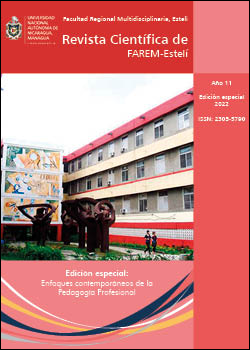CAD tools for the civil engineering career at the University of Holguin in Cuba from professionalized perspectives
DOI:
https://doi.org/10.5377/farem.v11i3.14891Keywords:
Career, Civil Engineering, professionalization, CAD tools, graphic representationAbstract
The objective of this research is to develop CAD tools in the civil engineering career from professionalized perspectives in order to introduce them in the subject Graphic Representation II. A study of the use of these CAD tools and the evaluation of their importance for the civil engineering career was carried out, as well as their applications in the construction field. In the development of the research process, theoretical, empirical and statistical methods were applied, which allowed obtaining information from different bibliographic sources as well as from practice, in order to support, justify the need for research and assess the relevance of the research developed. As a result, a transformation of the program and therefore of the conception of the subject in general was achieved. It was conceived based on the ministerial resolutions, the professional experience of the authors and the need to transform the vision of the use and professionalization of CAD tools in the teaching-learning process of civil engineering. It is concluded that the program is very successful, after its study and analysis by the specialists.
Downloads
References
Abreu, R. & Soler, J. (2015). Didáctica de la Educación Técnica y Profesional. Tomo I. Editorial Pueblo y Educación.
Alonso, L., A. Cruz, M., A. & Ronquillo, L. E. (2020). El proceso de enseñanza aprendizaje profesional: un enfoque actual para la formación del trabajador. Editorial Mar y Trinchera. Manta – Manabí – Ecuador.
Alonso, L., A. Cruz, M., A. & Ronquillo, L. E. (2022). Enseñanza aprendizaje profesional para formar trabajadores competentes. Editorial Libro Mundo. Ecuador.
Cruz, M., A., Zaragoza, N., I., Zúñiga, L., I., González, H. y Dotres, S. (2019). Problemas actuales de la Didáctica de las Ciencias de la Construcción. Ponencia presentada en la 9na Conferencia Científica Internacional de la Universidad de Holguín.
Dorta Cruz, L. y Zuñiga Igarza Libys Martha (2015). Programa de la asignatura para la formación económica de los ingenieros civiles. Trabajo de diploma en opción al título de Ingeniero Civil. Departamento de construcciones. Universidad de Holguín. 2015.
Ministerio de educación superior, (2018). Documento base para la elaboración del Plan de estudios E de la carrera de ingeniería civil. La Habana, Cuba.
Ministerio de educación superior, (2018). Resolución Ministerial N° 2 del 2018. Reglamento de trabajo docente y metodológico de la Educación Superior. La Habana, Cuba.
Ministerio de educación superior, (2019). Documento base del Plan de estudios E de la carrera de ingeniería civil en Holguín. Universidad de Holguín, Holguín, Cuba.
Téllez, L. (2005). Modelo didáctico del proyecto como forma de organización de la Práctica Preprofesional del Técnico Medio en Electricidad. (Tesis doctoral). Instituto Superior Pedagógico José de la Luz y Caballero, Holguín.
Urbina Reynaldo, M. O., & Cuervo Urbina, R. (2021). La Representación Gráfica en la carrera de Ingeniería Civil de la Universidad de Holguín, Cuba. Revista Científica de FAREM-Estelí, (37), 193–220. https://doi.org/10.5377/farem.v0i37.11218
UNESCO, (2013) Enfoques estratégicos sobre las TIC en educación en América Latina y el Caribe. Chile: OREALC/UNESCO.
UNESCO, (2016). Las TIC en la educación. Disponible en: http://www.unesco.org/new/es/unesco/themes/icts/
Valera, L. y Téllez, L. (2019). El proyecto profesional como forma de organización de la disciplina principal integradora de la carrera Licenciatura en Contabilidad y Finanzas. Revista Opuntia Brava, 8 (11), 204-213. Recuperado de: http:// http://opuntiabrava.ult.edu.cu/index.php/opuntiabrava/article/view/678.
Published
Issue
Section
License
Copyright (c) 2022 Revista Científica de FAREM-Esteli

This work is licensed under a Creative Commons Attribution-NonCommercial-ShareAlike 4.0 International License.



